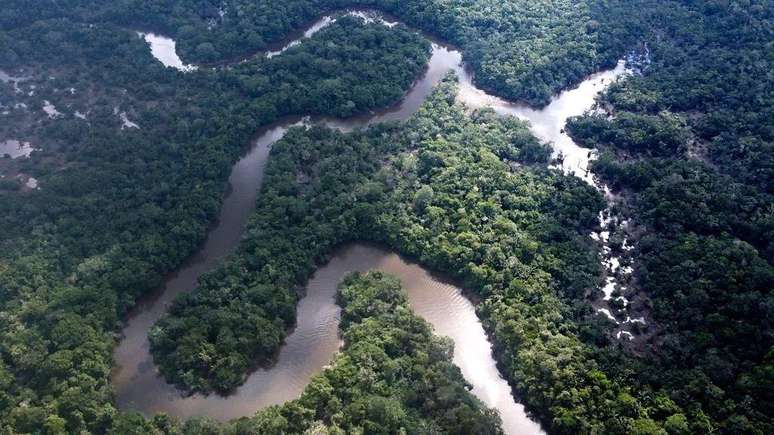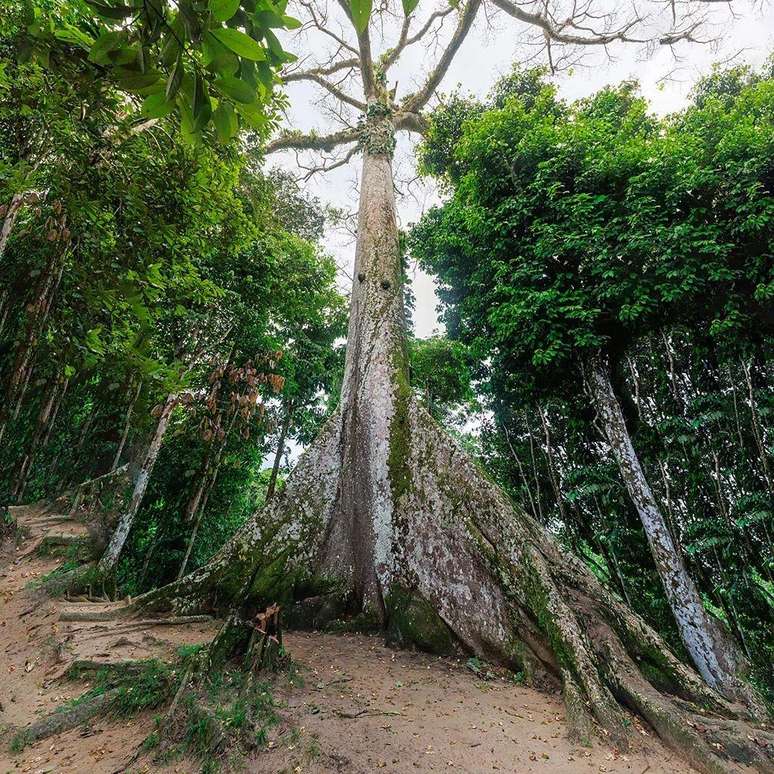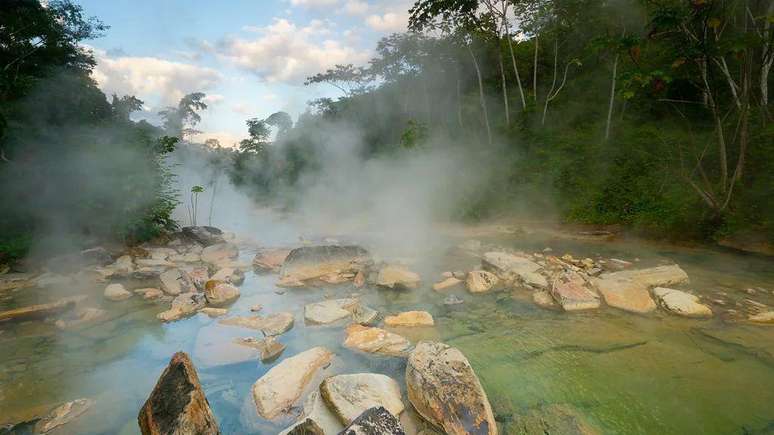The secrets of the Boiling River, also known as Shanay-Timpishka or La Bomba, is part of a tributary of the mighty Amazon River in Peru, and are only now being revealed by scientists.
When you arrive at Peru’s boiling river, after a bumpy four-hour journey through the forest, you can see the river in front of you only after crossing a high point of terrain, says Alyssa Kullberg, a postdoctoral researcher in the plant ecology school Federal Polytechnic of Lausanne, Switzerland (EPFL).
Huge waves of steam rise from a clump of trees into the large saucer-shaped depression below. “It was so magical!” Kullberg exclaims, remembering the first time he saw the place with his own eyes.
The Boiling River, also known as Shanay-Timpishka or La Bomba, is part of a tributary of the mighty Amazon River in east-central Peru.
In the 1930s, fossil fuel companies scoured the region’s hills for oil reserves. But only now are Western scientists fully revealing the secrets of the legendary boiling river.
The researchers concluded, for example, that geothermal sources deep underground keep the river warm.
Kullberg visited this mysterious place for the first time in 2022, with a team from the United States and Peru. Among the visitors was Riley Fortier, who is now a doctoral candidate at the University of Miami in the United States.
And as they walked through the forest, the researchers noticed something unusual in the plant life around them.
“It was evident to all of us that a clear and significant change was occurring along the river,” Fortier says. “The forest seemed to have more bushes. There weren’t any [tantas] big trees and it also seemed a little drier, the leaves on the ground were drier.”
Fortier remembers how impressed he was by the heat of that stretch of forest, even by Amazonian standards.
He and the other team members realized that the place represented a possible scenario for the changes that climate change could cause in the Amazon, with average air temperatures higher than today.
In this sense, the boiling river can be considered a sort of natural experiment, a possible vision of the future.
But studying the site wouldn’t be easy: “It felt like we were doing field work in a sauna,” Fortier says.

In a study published in October, Fortier, Kullberg and their colleagues from the United States and Peru describe how they monitored one year’s worth of air temperature readings near the Boiling River.
The researchers used 13 temperature recording devices, positioned along a stretch of river that included cooler areas, typical of the entire forest.
The average annual temperature ranged from 24 to 25 °C in these colder places, to 28 to 29 °C in the warmer parts.
Maximum air temperatures recorded, in some of the hottest locations along the Boiling River, reached nearly 45°C. And an earlier analysis (not yet published by a peer-reviewed journal) by geothermal scientist Andrés Ruzo concluded that the average water temperature is 86°C.
The team also braved the scorching conditions to produce a detailed analysis of the plant species present. They carefully studied the vegetation in a series of planted beds along the river and found an important correlation.
In the warmer parts of the river the vegetation was less dense and some species were completely absent.
“There was much less vegetation in the undergrowth,” explains Kullberg. “Even with a lot of steam, the vegetation seemed much drier.”
Some large trees – such as Guarea grandifolia, an evergreen tree that can grow up to 50 meters tall – appear to have more difficulty, for example, near warmer parts of the river.
In general, heat appears to have a negative influence on biodiversity. According to Fortier, the huge amount of vapor in the air could even drive flying insects or other animals away from the region, but the team’s study did not specifically address this issue.
As expected, plant species known to tolerate high temperatures were more common in warmer areas. But the team was surprised to observe this effect even at very small distances. The total length of the study area did not exceed approximately 2 km.
And the hottest parts of the boiling river are intermittent: there are some specific stretches with a lot of steam here and there.
The study’s results indicate that when temperatures reach a certain threshold, plant life reacts almost instantly.

“I thought it was incredible,” says Chris Boulton, of the University of Exeter, UK. He was not involved in the study, but refers to the team’s interpretation of the boiling river as a natural experiment. “It’s a smart decision.”
Warning sign
The boiling river is an example of possible future changes in the Amazon, according to Diego Oliveira Brandão, member of the Technical-Scientific Secretariat of the Scientific Group for the Amazon.
Brandão highlights his concern about the possible impact of these consequences of climate change on indigenous populations. “These populations depend on biological resources,” he explains.
Boulton agrees and points out that indigenous groups in the Amazon already face significant threats, such as floods and droughts, which have been exacerbated, in some cases, by climate change.
And rising temperatures in the Amazon could put the very functioning of many plants in the region at risk, according to Rodolfo Nóbrega, of the University of Bristol, in the United Kingdom. The boiling river illustrates this situation perfectly.
“Like the temperature [da região] increases, even if water is available [por perto]“, the ability of plants to photosynthesize may decrease,” he explains. “What I think is happening is that the plants are experiencing heat stress, even with water around them.”
But he points out that the study authors did not evaluate the temperature, nor the amount of groundwater available.
Kullberg says that while the boiling river does offer clues about the effects of rising temperatures on biodiversity and plant growth, it’s important to remember that this part of the Amazon may not exactly reflect the future of the forest in a broader sense.
You wouldn’t expect to find much steam in other places, for example. And major climate effects, such as changes in storms or precipitation patterns, will also influence the evolution of the forest as a whole in the coming years.
There is another reason why the boiling river may not accurately represent conditions in the Amazon basin as a whole, under the influence of climate change.
Nóbrega points out that the Amazon is huge. It covers parts of nine different countries: Brazil, Bolivia, Colombia, Ecuador, Peru, Venezuela and the three Guianas. In total, the forest covers an area of more than 6.7 million square kilometers.
“Something you find in one region may not be scientifically relevant to another that has a different precipitation pattern or a different plant distribution,” he explains.

Previously, Boulton and his colleagues had studied the possibility that the Amazon was reaching a “tipping point” that would cause climate change and deforestation to send the forest into rapid decline.
“You’ll be able to see sudden death of trees, maybe for about a decade,” Boulton says. And he points out that the Amazon isn’t getting hotter and drier just because of climate change.
One particularly insidious problem is deforestation, which can disturb the atmospheric rivers that flow through the air above the forest. It is they who bring moisture to the forest in the form of rain.
“If you cut down trees, you destroy this connection – basically, you make the forest drier,” he explains.
A major report on several global hotspots – published in 2023 by more than 200 researchers including Boulton – details the risk that the Amazon rainforest will soon transform into a much drier place, more like a savannah than a forest.
However, by studying the boiling river, we can get an idea of which species are most likely to survive in these new and more difficult conditions, according to Fortier.
He highlights the example of the giant kapok tree (Ceiba lupuna). This tree species can grow up to 50 meters tall.
The pot-bellied kapok appears to be resistant to warmer temperatures near the boiling river, Kullberg said. And previous research confirms this observation.

Kullberg points out that the kapok can store water in its trunk, which helps it survive droughts.
Confirming that specific plants can withstand the extreme environment of the boiling river could help conservationists decide which parts of the forest need the most protection, according to Fortier. And Kullberg adds that it may be possible to maintain milder microclimates under the canopy of forests made up of resistant species.
Boulton emphasizes that protecting the Amazon is a way of protecting humanity, far beyond the forest. After all, if the forest truly reaches a catastrophic tipping point, beyond which it begins to die rapidly, the risk is that the entire world will pay the consequences.
“If the forest disappeared, much of that carbon would end up in the atmosphere, affecting the climate,” he explains. “It’s not just local, it’s global.”
Therefore, the boiling river is not just a vision of the future. It’s a warning sign.
Read the original version of this report (in English) on the site BBC Earth.
Source: Terra
Rose James is a Gossipify movie and series reviewer known for her in-depth analysis and unique perspective on the latest releases. With a background in film studies, she provides engaging and informative reviews, and keeps readers up to date with industry trends and emerging talents.







